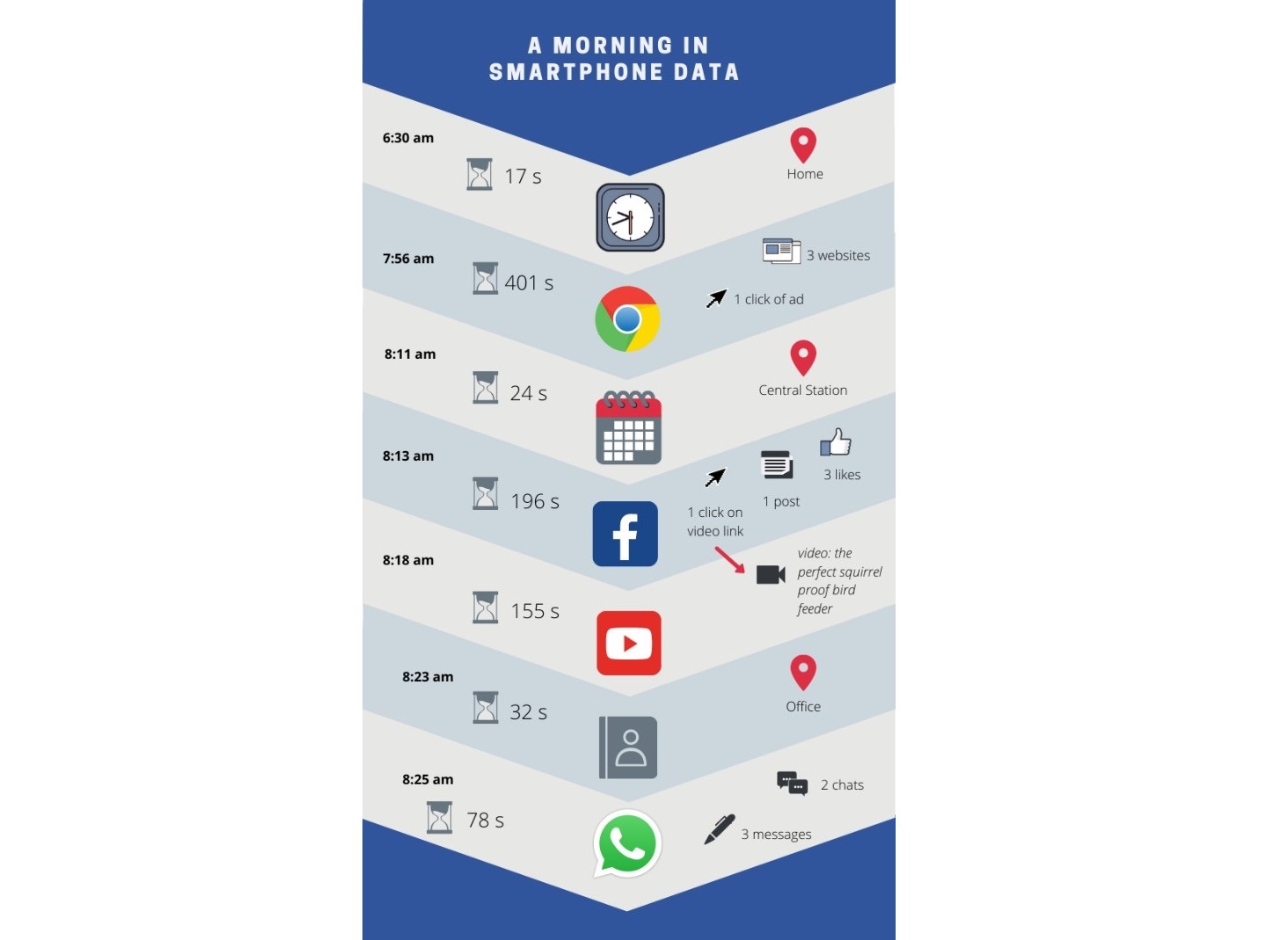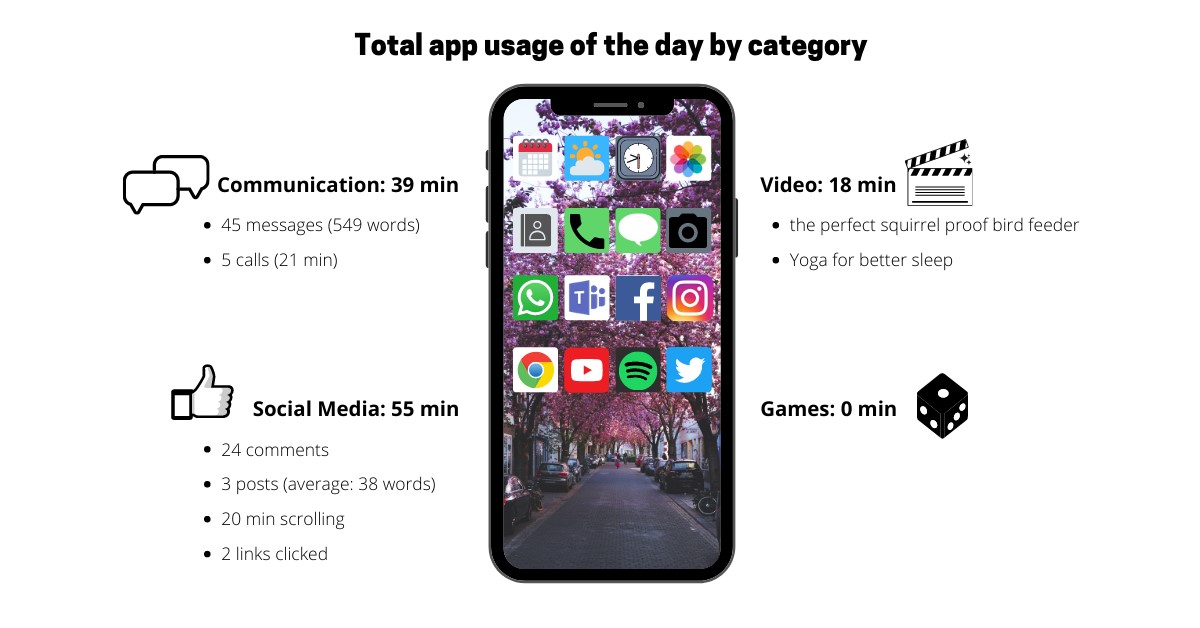What smartphone data reveals about human behavior - Opportunities for academic researchers
By Murmuras on Oct 21, 2020
As constant companions, smartphones provide unique insights into people’s daily lives and behaviors. While big tech companies have been using these insights for over 10 years, the method is only now emerging in the academic world. But what exactly can be measured with smartphone data? Which academic researcher can actually benefit from using this method? And what about data privacy?
Here we will demonstrate what information academic researchers can get by looking at the smartphone data obtained from a test study. For many research questions, this method may be more beneficial as it can overcome some downsides of traditional research methods such as surveys. It is easy to use for both researchers and participants and requires no personal meetings. Smartphone data can be used to analyze thousands of objective data points per day. This includes the following data types: a) phone & app usage over time, b) location data, c) app content. Let’s dive into a practical example.
What Smartphone data reveals - a practical example
The figure below shows the data of one morning of a test user, let’s call her Marta. The study was conducted by Murmuras with real data and has been modified in agreement with the participant. The data contains information about the time flow of her smartphone and app usage. Thanks to GPS and other location information, inferences can be made about her whereabouts. Furthermore, app content information reveals more in-depth insights. Here is Marta’s morning in detail:

6:30 am: Marta first uses her phone. At this time, she opens the Clock app for 17 seconds. The sensors of her phone indicates that she is at her home.
7:56 am: She opens Chrome for 401 seconds, about 7 minutes. During this time, she browses three websites and clicks on one add. Based on the GPS tracking, it is clear that she has left her home by now, and based on the speed estimates, she is probably walking.
8:11 am: Marta checks the Calendar for 24 seconds. She has stopped at the GPS location of the Central Station of the city she lives in by now.
From 8:12 am till 8:21 am, Marta is moving at driving speed. She likely caught a bus from the station. During the ride, she checks Facebook: She likes three posts, writes one herself (30 words), and then clicks on the link to a video. The link leads her to Youtube: For about 2.5 minutes, she is watching a video on how to build a squirrel-proof bird feeder.
8:23 am: she enters her office. Marta immediately checks her Contacts. Then, she switches to WhatsApp and writes three messages in two different chats. She takes 78 seconds for this.
This example shows that a time window of about 2 hours can already provide a lot of insights into Marta’s behavior. Such a detailed sequence of Marta’s smartphone data is collected throughout the whole day. The data gives indications of when she goes home from work (she leaves the GPS of her work at 5:20 pm), when she goes to sleep (she used her phone last at 11:20 pm when she sets the alarm to 6:30 am again), and whether she sleeps through (no, she unlocks her phone twice at 3:00 and one time at 4:23).
As Marta carries her phone with her anyways – such a detailed sequence of Marta’s smartphone data is easily obtained over extended periods. Consequently, better inferences and judgments about Marta’s behavior can be made.

Another way of examining the data is by looking at the app usage summary in relation to Marta’s average daily phone usage. On this particular day, the test user Marta unlocked her phone 120 times and used it for 3.5 hours. Compared to the average female user in her age, she used her phone 21 minutes less.
Which academic researchers can benefit from collecting smartphone data?
In general, all researchers who study human behavior can benefit from collecting data using smartphone sensing. While the described example does not allow for any generalized inferences, it does give a hint on various research questions that can be better analyzed by smartphone data. The method can help to tackle behavioral research questions in fields including (but not limited to!) Psychology, Media and Communication Science, City planning, User Experience, and Marketing. Three examples:
How do people make decisions in different locations (checks Google Maps for transport method decision, checks TripAdvisor for a restaurant in the city, etc.)?
What are patterns of interaction on social media?
Health: sleeping patterns, outdoor activity, smartphone addiction, etc.
What about data privacy?
Data protection regulations and ethical concerns vary widely from region to region. But even in areas with stricter regulations like Europe (GDPR), researchers can run studies to analyze smartphone data, as long as probands’ rights are respected. However, the ethical issues that arise in academic research extend beyond data privacy because there are international ethical and scientific standards, such as the Declaration of Helsinki and the DFG Memorandum, on ensuring good scientific practice. In our opinion, clear and transparent communication to participants is crucial when sensitive data is collected. Participation in a study should always be voluntary, and it should be possible to terminate without giving reasons at any time. Furthermore, it should be ensured that any non-communicated use of data (i.e., target advertisement) or even disclosure to third parties is excluded.